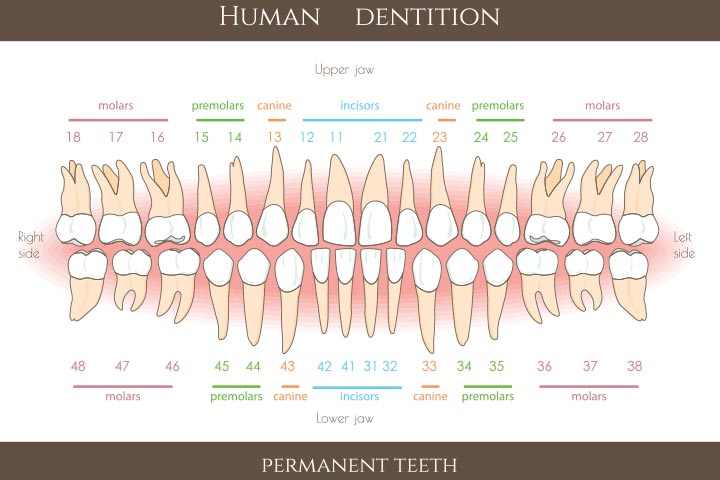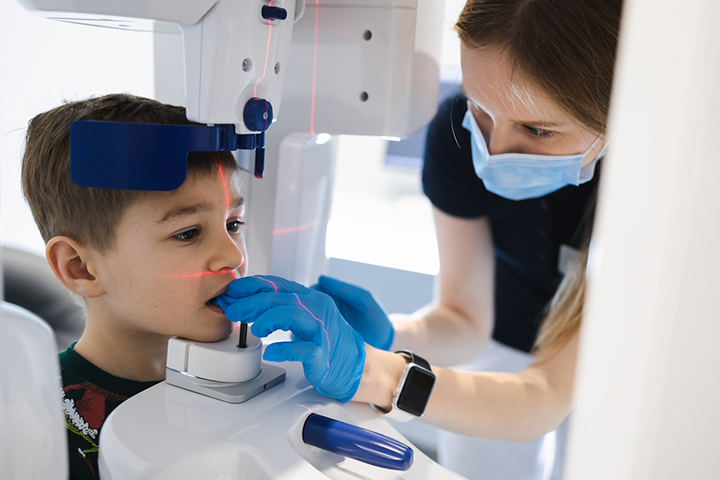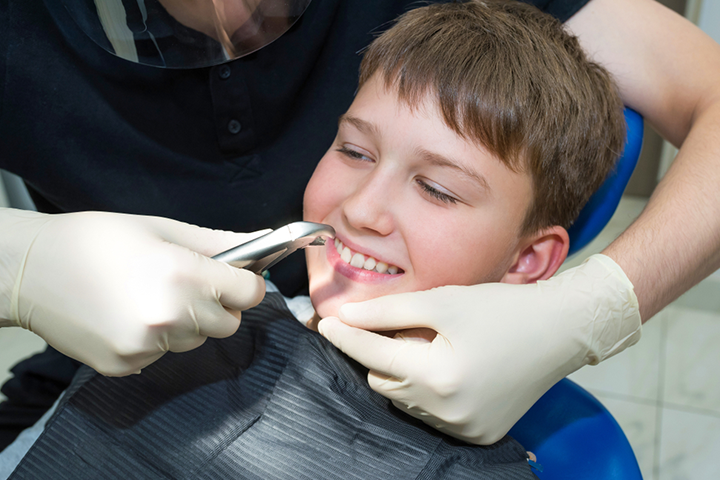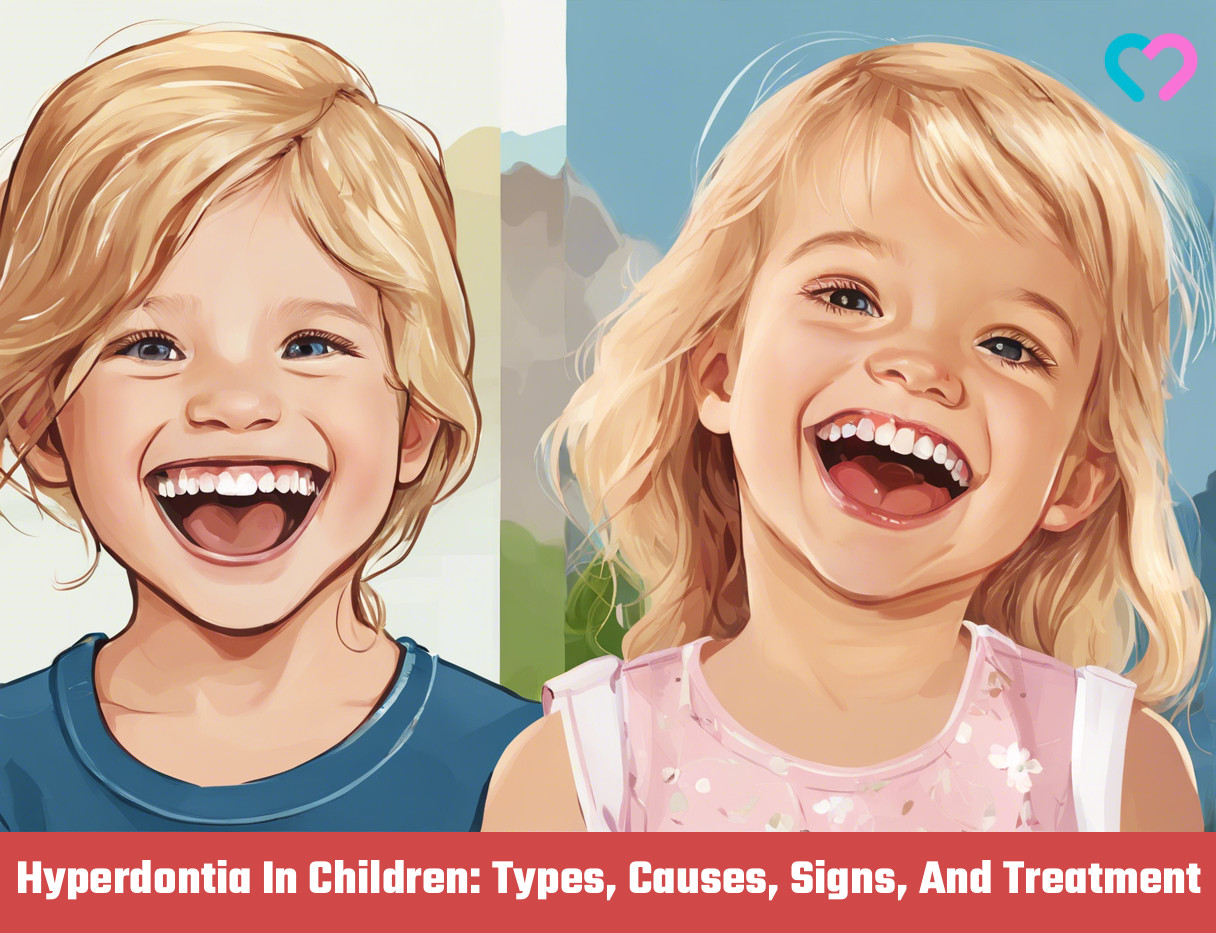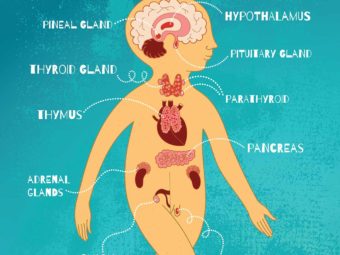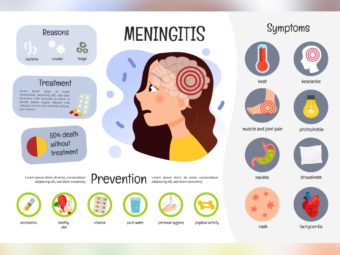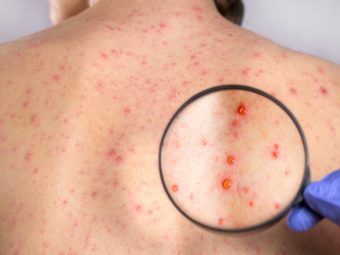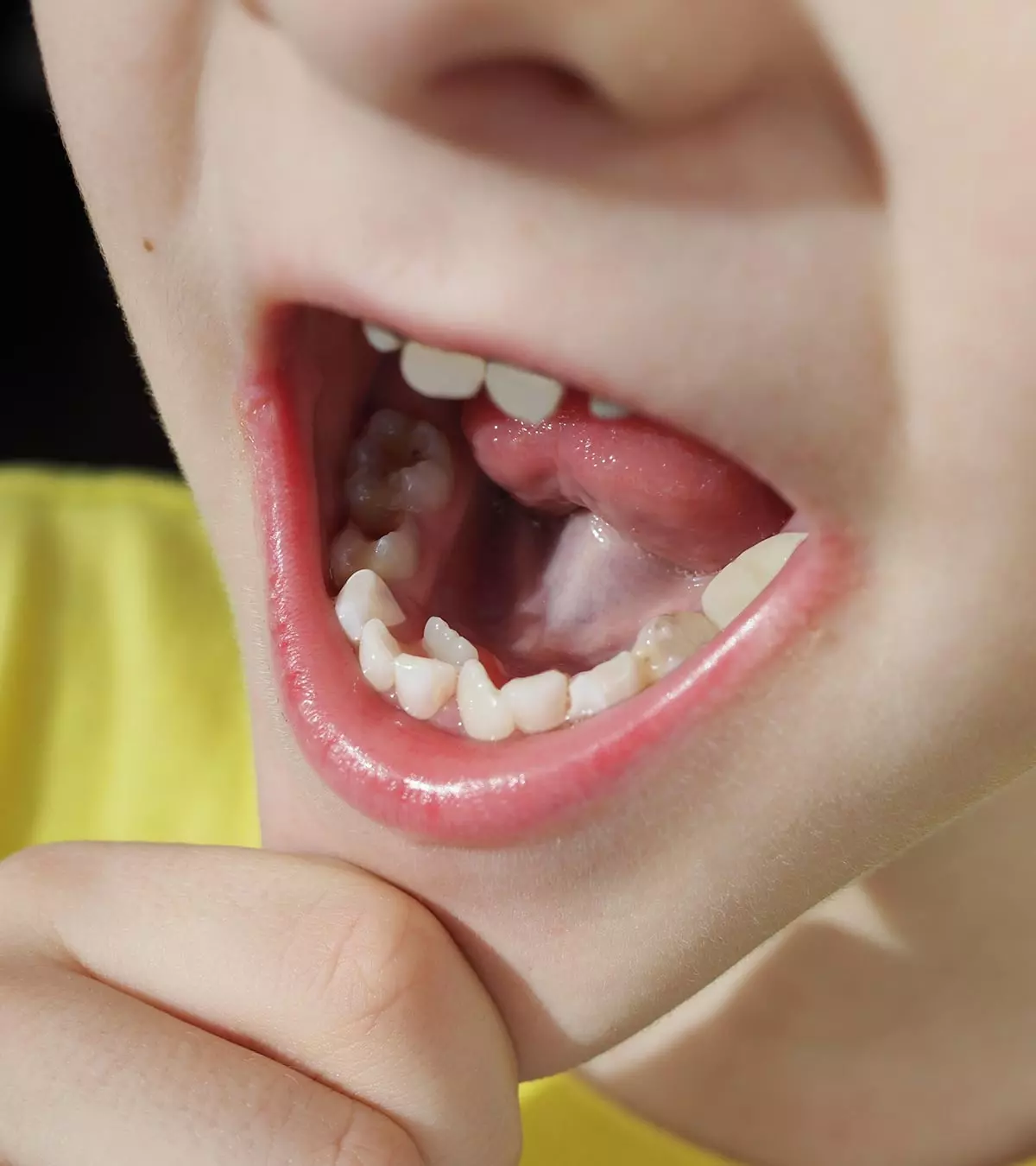
Hyperdontia in children is a rare condition in which extra teeth grow in the mouth. Usually, children have 20 deciduous teeth (primary teeth) by 30 months, while adults have 32 permanent teeth by the age of 17. As children grow, the primary teeth or primary dentition are gradually replaced by permanent dentition, comprising 32 teeth. Some children may get extra teeth on the upper or lower jaw, called supernumerary teeth. Depending on when they get, these can be permanent or primary (1).
Hyperdontia is a developmental problem, and there is a 3.8% incidence rate in children (2) (3). The incidence rate is twice as frequent in boys as in girls. Keep reading this post to know the causes, types, and effects of hyperdontia in children.
Types Of Hyperdontia
Pediatric dentistry classifies supernumerary teeth based on the tooth/teeth shape and location (4) (5).
The following is the classification based on the shape.
- Conical: This tooth is small and peg-shaped (wider base and narrower top) with normal roots.
- Tuberculate: This tooth is barrel-shaped and has a rudimentary root. It often occurs in pairs.
- Supplemental (eumorphic): This can be described as duplication of a tooth. The supplementary tooth is similar to the tooth near it.
- Odontome: This tooth has no defined or regular shape. It appears more like a disorganized and diffused mass of dental tissue.
The following are the types of extra supernumerary teeth based on location.
- Mesiodens: The supplementary tooth is located between two central incisors. It is the most common type of supplementary tooth.
- Paramolar: The supplementary molar or extra tooth grows buccally or palatally (towards the back of the mouth) to one of the molars.
- Distomolar: The tooth grows posterior or distal (behind) the third molar.
- Parapremolar: The extra tooth grows in the premolar region.
The extra teeth can appear as a single tooth, as well as multiple teeth. However, multiple supplementary teeth are rarely seen and are mostly associated with conditions such as cleft lip or palate and Gardner syndrome (1).
Symptoms Of Hyperdontia In Children
Image: Shutterstock
The main symptom is the growth of extra tooth or teeth near a primary or permanent tooth. Your child might even complain about an extra tooth in the mouth. A doctor can determine the type of supernumerary teeth by examining the location and morphology (shape) of the extra tooth or teeth.
Causes Of Hyperdontia In Children
The causes of hyperdontia are not well understood. However, the condition has been associated with factors including genetics, familial tendency, and overactive dental lamina (the part that initiates tooth formation) (1) (4) (6).
- Cleidocranial dysplasia: This genetic condition affects the development of bones and teeth. Individuals with cleidocranial dysplasia often display the development of supernumerary teeth in any part of the dental arch and retention of primary teeth (7).
- Cleft lip and palate: This condition is a birth defect and occurs when a baby’s lip or palate of the mouth (upper part of the mouth) does not form properly during pregnancy. This results in an opening in the upper lip and is likely to result in hyperdontia (8). According to the Centres for Disease Control and Prevention (CDC) approximately 1 in every 1,700 babies is born with cleft palate in the US.
- Gardner syndrome: This rare genetic disease causes multiple colorectal polyps and various types of tumors (benign and malignant). This disease can increase the risk of developing supernumerary teeth, along with other dental anomalies or problems (9).
- Ehlers-Danlos syndrome: This genetic group of disorders affects connective tissues supporting blood vessels, skin, bones, and other organs. This condition can cause loose joints and other life-threatening conditions (10). Dental development abnormalities are one of the many symptoms of the condition.
- Down syndrome: This is a genetic condition where an individual has an extra chromosome number 21 (11). This syndrome is characterized by distinct facial features, intellectual disability (mild to moderate), and birth defects, including the probability of having hyperdontia.
- Fabry-Anderson syndrome: It is one of the hereditary conditions that cause the accumulation of a certain type of fat in the body’s cells. It may cause several signs and symptoms, like hyperdontia, pain in hands and feet, dark red spots on the skin, hearing loss, and decreased ability to sweat (12).
How Is Hyperdontia Diagnosed?
Image: IStock
Supernumerary teeth are detected through an X-ray or dental radiography examination of the mouth. Healthcare practitioners may also thoroughly evaluate family and medical history, along with clinical examination (5). The presence of supernumerary teeth can be suspected if there is no eruption of permanent teeth (5).
 Quick fact
Quick factTreatment Of Hyperdontia In Children
Periodic dental assessment is vital to early diagnosis and appropriate treatment necessary to avoid dental complications in the case of hyperdontia. The treatment options may vary depending on the location and type of supernumerary teeth and its effect on the neighboring teeth or tissues. Treatment options include (5).
- Tooth extraction or removal: Clinicians may suggest extraction or removal of the supernumerary tooth in the following cases.
Image: Shutterstock
- There is a complication associated with it.
- There is a delay in the eruption of a permanent tooth.
- There is an increased risk of infection since extra teeth may make it difficult to maintain oral health and hygiene.
- There is misalignment, displacement, or rotation of a neighboring tooth.
- Extra teeth cause aesthetic (appearance) or functional issues.
- Endodontic therapy (root canal): If a supernumerary tooth has fused with a permanent tooth, then the doctor may recommend root canal treatment.
- Clinical follow-up or frequent observation: In some cases, doctors may not extract the supernumerary tooth but keep it under observation until the eruption of the adjacent teeth. If the child does not face any problems, such as pain, and there is no risk of future complications, like infection, then the doctor might let the extra tooth or teeth remain in the mouth.
Complications Associated With Hyperdontia In Children
Image: Shutterstock
Complications of supernumerary teeth include (1) (2) (6).
- Failure of eruption: Supernumerary or extra tooth causes eruption disturbances as it interferes with the normal development of the permanent tooth.
- Displacement or rotation: Supernumerary tooth may cause displacement or rotation of a permanent tooth.
- Overcrowding: Growth of extra teeth results in crowding, causing aesthetic or functional problems, such as malocclusion. When a child has malocclusion, their upper and lower teeth don’t align when they close their mouth.
- Diastemas: These extra teeth may also create a gap or space between teeth (usually in the front teeth of the upper jaw).
- Development of odontogenic cyst: Supernumerary teeth can cause the formation of jaw cysts or tumors.
- Root resorption of neighboring (adjacent) teeth: Although rare, supernumerary teeth may cause root resorption (breaking down leading to loss) of neighboring teeth.
- Eruption in the nasal cavity: Sometimes, tooth eruption may happen in the nasal cavity and can be seen as a white mass in the nasal area.
Hyperdontia can also increase the risk of tooth impaction, which can cause pain, swelling, and even infection.
 Quick fact
Quick factFrequently Asked Questions
1. At what age does hyperdontia occur?
Hyperdontia has been reported in children as young as three years (1).
2. Is hyperdontia painful?
Pain may not occur due to hyperdontia. However, its complications, such as intraoral infection, may result in pain (2).
3. Does hyperdontia go away?
Hyperdontia cannot self-resolve. Instead, it requires surgical correction as an orthodontic treatment option.
4. Is hyperdontia hereditary?
Supernumerary teeth are known to occur due to genetic and environmental causes, with a more prominent incidence among children whose parent(s) or family members have had hyperdontia. In addition, studies indicate that hyperdontia may be transmitted from parent to child as an autosomal dominant or recessive trait (13) (14).
5. Can a brace fix hyperdontia?
Hyperdontia requires an extraction treatment to avoid overcrowding and gum problems in the mouth. However, after removing the supernumerary teeth, braces may be used to realign the teeth that had gotten pushed out due to the extra growth (15).
Hyperdontia in children is not a common condition. It may lead to issues with speech, mastication, and aesthetics. Your child’s dentist will mostly diagnose the condition during your regular dental check-up. A physical dental examination can help a dentist diagnose the presence of supernumerary teeth. The condition may run in families. If there is a tooth that constantly pinches your tongue or cheeks, it is recommended to see a dentist as soon as possible. Dental extractions are the best treatment for most cases.
Infographic: Is Having Extra Teeth Genetic?
Teeth abnormalities in size, shape, and number can be linked to environmental and genetic factors. Hyperdontia or having extra teeth can be linked to various genetic syndromes. Go through the infographic to know genetic diseases linked to hyperdontia. Illustration: Momjunction Design Team
Key Pointers
- Hyperdontia is a rare condition in children characterized by the growth and presence of extra teeth in the upper or lower jaw.
- Supernumerary teeth are classified into different types based on their morphology and location.
- Cleidocranial dysplasia, Gardner syndrome, Ehlers-Danlos syndrome, and Down syndrome are some conditions causing hyperdontia in children.
- Hyperdontia can be diagnosed and identified using an x-ray and examination of the mouth.
- The extra tooth could be removed if they obstruct normal eruption and growth of adjacent teeth or cause other complications.
- Tooth displacement, overcrowding, diastemas, cyst development, root desorption, and eruption in the nasal cavity are some complications associated with hyperdontia.
Image: Stable Diffusion/MomJunction Design Team
Hyperdontia is a condition where extra teeth grow in the mouth. Find out about the causes, signs and symptoms, diagnosis, and treatment options from this video.
References
1. Sharma, A. and Singh V. P., Supernumerary teeth in Indian children: a survey of 300 cases; International Journal Of Dentistry
2. Meighani G. and Pakdaman A., Diagnosis and management of supernumerary (mesiodens): a review of the literature; Journal of Dentistry
3. American Academy of Pediatric Dentistry, Management considerations for pediatric oral surgery and oral pathology (Reference manual): The Reference Manual of Pediatic Dentistry
4. Kirtaniya B. C. et al., Review of Supernumerary Teeth and their Management in Children; International Journal of Oral Health and Medical Research
5. Parolia A. et al., Management of supernumerary teeth; Journal of Conservative Dentistry
6. Demiriz L., Durmuslar M.C., and Misir A.F., Prevalence and characteristics of supernumerary teeth: A survey on 7348 people; Journal of International Society of Preventive & Community Dentistry
7. Cleidocranial dysplasia; Genetic Home Reference, U.S. National Library of Medicine
8. Facts about cleft lip and cleft palate; Centers for Disease Control and Prevention
9. Gardner syndrome; Genetic and Rare Diseases Information Center, National Center for Advancing Translational Sciences
10. Ehlers-Danlos syndrome; Genetic Home Reference, U.S. National Library of Medicine
11. Downs syndrome; Centers for Disease Control and Prevention
12. Fabry disease; Genetic Home Reference, U.S. National Library of Medicine
13. Asli Subasioglu et al.;Genetic background of supernumerary teeth; NCBI (2015)
14. Non-syndromic multiple supernumerary teeth in a family unit with a normal karyotype: case report; International Journal of Medical Sciences
15. Dr. Napitu and Dr. Scharf; What is Hyperdontia? Extra Teeth Causes, Problems and Treatments; Dentaly (2019)





